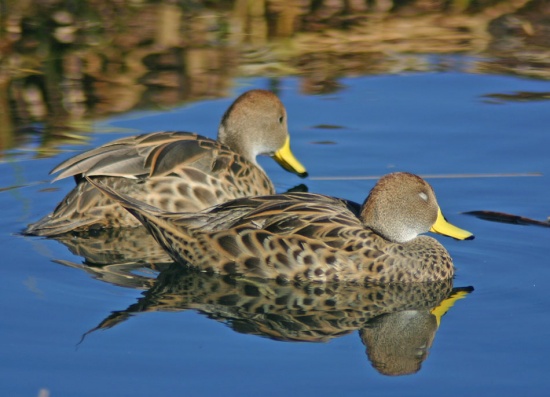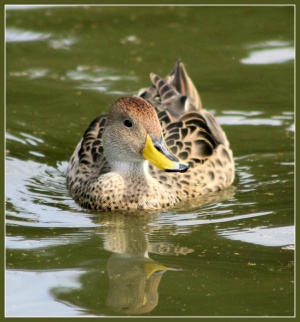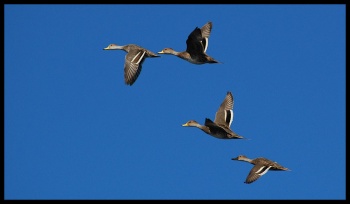m (edit distribution) |
(→External Links: New combined GSearch. GSearch checked template) |
||
| (7 intermediate revisions by 5 users not shown) | |||
| Line 1: | Line 1: | ||
| − | [[ | + | [[Image:Yellow-billed_Pintail.jpg|thumb|550px|right|Photo © by {{user|JanArras|JanArras}}<br />Lake Titicaca, [[Peru]], July 2005]] |
| + | |||
;[[:Category:Anas|Anas]] georgica | ;[[:Category:Anas|Anas]] georgica | ||
| − | |||
| − | |||
==Identification== | ==Identification== | ||
| − | 61-71cm | + | 61-71cm |
| + | *Pale warm brown head and neck, finely mottled darker | ||
| + | *Lighter throat | ||
| + | *Buffish-brown body with noticeable blackish-brown feather centres | ||
| + | *Spotted on breast and along flanks and upperparts | ||
| + | [[Image:Yellow-billed_Pintail_by_luisrock62.jpg|thumb|300px|right|Photo showing black culmen<br />Photo © by {{user|luisrock62|luisrock62}}<br />Buenos Aires, [[Argentina]], February 2005]] | ||
| + | *Pale belly | ||
| + | *Brown, long and pointed tail | ||
| + | *Greyish-brown upperwing, with buff tips to greater [[Topography#General Anatomy|coverts]]; secondaries *Blackish-green [[Topography#General Anatomy|secondaries]], with broad buff tips | ||
| + | *Bright yellow bill with black tip and [[Topography#Beaks|culmen]]. | ||
| + | Sexes similar | ||
==Distribution== | ==Distribution== | ||
| − | + | ||
| + | [[South America]]: found from southern [[Colombia]], [[Ecuador]], [[Peru]], [[Uruguay]], south-eastern [[Brazil]], through [[Argentina]], [[Chile]] to [[Tierra del Fuego]], and additionally in the [[Falkland Islands]] and [[South Georgia Islands]]. | ||
==Taxonomy== | ==Taxonomy== | ||
| − | Three subspecies are recognized: | + | ====Subspecies==== |
| − | *''georgica'' is only found in South Georgia Islands | + | Three subspecies are recognized<sup>[[#References|[2]]]</sup>: |
| − | *''spinicauda'' is the widespread [[South America]]n form also found in the | + | *''A. g. georgica'' is only found in [[South Georgia]] Islands |
| − | *'' | + | *''A. g. spinicauda'' is the widespread [[South America]]n form also found in the [[Falkland Islands]] |
| + | *''A. g. niceforoi'' from central [[Colombia]] is apparently extinct | ||
| + | [[Image:Pato jergon grande.jpg|thumb|350px|right|Photo © by {{user|Rodrigo+Reyes|Rodrigo Reyes}}<br />El Yali, central [[Chile]], June 2007]] | ||
All three forms have in the past been considered distinct species, and their lumping apparently was not accompanied by any arguments<sup>[[#References|1]]</sup>. | All three forms have in the past been considered distinct species, and their lumping apparently was not accompanied by any arguments<sup>[[#References|1]]</sup>. | ||
==Habitat== | ==Habitat== | ||
| Line 19: | Line 31: | ||
==Behaviour== | ==Behaviour== | ||
| − | + | ====Breeding==== | |
| − | + | Ground nesters; the nest is concealed in amongst vegetation and lined with down and grass. The clutch consists of 4 to 10 eggs. | |
| − | + | ====Diet==== | |
| + | A dabbling duck, they also wade in shallow water or graze in waterside grasslands, only occasionally diving. Their diet consists of seeds, roots, grass and algae. | ||
==References== | ==References== | ||
# Restall et al. 2006. Birds of Northern South America. Yale University Press. ISBN 9780300124156 | # Restall et al. 2006. Birds of Northern South America. Yale University Press. ISBN 9780300124156 | ||
| − | # | + | #{{Ref-Clements6thAug14}}# Alvaro Jaramillo. 2003. Birds of Chile. Princeton Field Guides. ISBN 0-691-11740-3 |
| − | # Alvaro Jaramillo. 2003. Birds of Chile. Princeton Field Guides. ISBN 0-691-11740-3 | + | #Wildfowl: An Identification Guide to the Ducks, Geese and Swans of the World. Steve Madge |
| + | #Handbook of the Birds of the World Alive (retrieved January 2015) | ||
| + | {{ref}} | ||
==External Links== | ==External Links== | ||
| − | {{GSearch|Anas | + | {{GSearch|"Anas georgica" {{!}} "Yellow-billed Pintail"}} |
| + | {{GS-checked}}1 | ||
| + | <br /> | ||
| + | <br /> | ||
| − | [[Category:Birds]] | + | [[Category:Birds]] [[Category:Anas]] |
Latest revision as of 23:53, 17 March 2023
- Anas georgica
Identification
61-71cm
- Pale warm brown head and neck, finely mottled darker
- Lighter throat
- Buffish-brown body with noticeable blackish-brown feather centres
- Spotted on breast and along flanks and upperparts
- Pale belly
- Brown, long and pointed tail
- Greyish-brown upperwing, with buff tips to greater coverts; secondaries *Blackish-green secondaries, with broad buff tips
- Bright yellow bill with black tip and culmen.
Sexes similar
Distribution
South America: found from southern Colombia, Ecuador, Peru, Uruguay, south-eastern Brazil, through Argentina, Chile to Tierra del Fuego, and additionally in the Falkland Islands and South Georgia Islands.
Taxonomy
Subspecies
Three subspecies are recognized[2]:
- A. g. georgica is only found in South Georgia Islands
- A. g. spinicauda is the widespread South American form also found in the Falkland Islands
- A. g. niceforoi from central Colombia is apparently extinct
All three forms have in the past been considered distinct species, and their lumping apparently was not accompanied by any arguments1.
Habitat
Variety of wetlands, from high-elevation lakes and marshes to lowland lakes and rivers in open country.
Behaviour
Breeding
Ground nesters; the nest is concealed in amongst vegetation and lined with down and grass. The clutch consists of 4 to 10 eggs.
Diet
A dabbling duck, they also wade in shallow water or graze in waterside grasslands, only occasionally diving. Their diet consists of seeds, roots, grass and algae.
References
- Restall et al. 2006. Birds of Northern South America. Yale University Press. ISBN 9780300124156
- Clements, J. F., T. S. Schulenberg, M. J. Iliff, D. Roberson, T. A. Fredericks, B. L. Sullivan, and C. L. Wood. 2014. The eBird/Clements checklist of birds of the world: Version 6.9., with updates to August 2014. Downloaded from http://www.birds.cornell.edu/clementschecklist/download/
- Alvaro Jaramillo. 2003. Birds of Chile. Princeton Field Guides. ISBN 0-691-11740-3
- Wildfowl: An Identification Guide to the Ducks, Geese and Swans of the World. Steve Madge
- Handbook of the Birds of the World Alive (retrieved January 2015)
Recommended Citation
- BirdForum Opus contributors. (2025) Yellow-billed Pintail. In: BirdForum, the forum for wild birds and birding. Retrieved 14 May 2025 from https://www.birdforum.net/opus/Yellow-billed_Pintail
External Links
GSearch checked for 2020 platform.1






